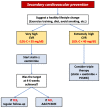Soluble PCSK9 Inhibition: Indications, Clinical Impact, New Molecular Insights and Practical Approach-Where Do We Stand?
- PMID: 37109259
- PMCID: PMC10146045
- DOI: 10.3390/jcm12082922
Soluble PCSK9 Inhibition: Indications, Clinical Impact, New Molecular Insights and Practical Approach-Where Do We Stand?
Abstract
Current research on cardiovascular prevention predominantly focuses on risk-stratification and management of patients with coronary artery disease (CAD) to optimize their prognosis. Several basic, translational and clinical research efforts aim to determine the etiological mechanisms underlying CAD pathogenesis and to identify lifestyle-dependent metabolic risk factors or genetic and epigenetic parameters responsible for CAD occurrence and/or progression. A log-linear association between the absolute exposure of LDL cholesterol (LDL-C) and the risk of atherosclerotic cardio-vascular disease (ASCVD) was well documented over the year. LDL-C was identified as the principal enemy to fight against, and soluble proprotein convertase subtilisin kexin type 9 (PCSK9) was attributed the role of a powerful regulator of blood LDL-C levels. The two currently available antibodies (alirocumab and evolocumab) against PCSK9 are fully human engineered IgG that bind to soluble PCSK9 and avoid its interaction with the LDLR. As documented by modern and dedicated "game-changer" trials, antibodies against soluble PCSK9 reduce LDL-C levels by at least 60 percent when used alone and up to 85 percent when used in combination with high-intensity statins and/or other hypolipidemic therapies, including ezetimibe. Their clinical indications are well established, but new areas of use are advocated. Several clues suggest that regulation of PCSK9 represents a cornerstone of cardiovascular prevention, partly because of some pleiotropic effects attributed to these newly developed drugs. New mechanisms of PCSK9 regulation are being explored, and further efforts need to be put in place to reach patients with these new therapies. The aim of this manuscript is to perform a narrative review of the literature on soluble PCSK9 inhibitor drugs, with a focus on their indications and clinical impact.
Keywords: CAD; LDL; PCSK9; cardiovascular prevention; lipidology; precision medicine.
Conflict of interest statement
The authors declare no conflict of interest.
Figures


Similar articles
-
Proprotein convertase subtilisin/kexin type 9 (PCSK9) inhibitors: Present perspectives and future horizons.Nutr Metab Cardiovasc Dis. 2016 Oct;26(10):853-62. doi: 10.1016/j.numecd.2016.05.006. Epub 2016 May 30. Nutr Metab Cardiovasc Dis. 2016. PMID: 27352986 Review.
-
Recent Updates on the Use of PCSK9 Inhibitors in Patients with Atherosclerotic Cardiovascular Disease.Curr Atheroscler Rep. 2019 Mar 16;21(5):16. doi: 10.1007/s11883-019-0778-6. Curr Atheroscler Rep. 2019. PMID: 30877491 Review.
-
Systematic Review for the 2018 AHA/ACC/AACVPR/AAPA/ABC/ACPM/ADA/AGS/APhA/ASPC/NLA/PCNA Guideline on the Management of Blood Cholesterol: A Report of the American College of Cardiology/American Heart Association Task Force on Clinical Practice Guidelines.Circulation. 2019 Jun 18;139(25):e1144-e1161. doi: 10.1161/CIR.0000000000000626. Epub 2018 Nov 10. Circulation. 2019. PMID: 30586775
-
Advances in dyslipidemia management for prevention of atherosclerosis: PCSK9 monoclonal antibody therapy and beyond.Cardiovasc Diagn Ther. 2017 Apr;7(Suppl 1):S11-S20. doi: 10.21037/cdt.2017.03.02. Cardiovasc Diagn Ther. 2017. PMID: 28529918 Free PMC article. Review.
-
Systematic Review for the 2018 AHA/ACC/AACVPR/AAPA/ABC/ACPM/ADA/AGS/APhA/ASPC/NLA/PCNA Guideline on the Management of Blood Cholesterol: A Report of the American College of Cardiology/American Heart Association Task Force on Clinical Practice Guidelines.J Am Coll Cardiol. 2019 Jun 25;73(24):3210-3227. doi: 10.1016/j.jacc.2018.11.004. Epub 2018 Nov 10. J Am Coll Cardiol. 2019. PMID: 30423394
Cited by
-
DNA methylation and histone post-translational modifications in atherosclerosis and a novel perspective for epigenetic therapy.Cell Commun Signal. 2023 Nov 29;21(1):344. doi: 10.1186/s12964-023-01298-8. Cell Commun Signal. 2023. PMID: 38031118 Free PMC article. Review.
-
Invasive and Non-invasive Assessment of Non-culprit Coronary Lesions in Patients with ST-segment Elevation Myocardial Infarction.Transl Med UniSa. 2024 May 2;26(1):38-45. doi: 10.37825/2239-9747.1050. eCollection 2024. Transl Med UniSa. 2024. PMID: 38957729 Free PMC article. Review.
-
Current Management of Highly Calcified Coronary Lesions: An Overview of the Current Status.J Clin Med. 2023 Jul 23;12(14):4844. doi: 10.3390/jcm12144844. J Clin Med. 2023. PMID: 37510959 Free PMC article. Review.
-
ApoB100 and Atherosclerosis: What's New in the 21st Century?Metabolites. 2024 Feb 12;14(2):123. doi: 10.3390/metabo14020123. Metabolites. 2024. PMID: 38393015 Free PMC article. Review.
-
Novel Targets and Strategies Addressing Residual Cardiovascular Risk in Post-acute Coronary Syndromes Patients.Transl Med UniSa. 2024 Aug 28;26(2):99-110. doi: 10.37825/2239-9747.1058. eCollection 2024. Transl Med UniSa. 2024. PMID: 39385797 Free PMC article. Review.
References
-
- Silverio A., Di Maio M., Citro R., Esposito L., Iuliano G., Bellino M., Baldi C., De Luca G., Ciccarelli M., Vecchione C., et al. Cardiovascular risk factors and mortality in hospitalized patients with COVID-19: Systematic review and meta-analysis of 45 studies and 18,300 patients. BMC Cardiovasc. Disord. 2021;21:23. doi: 10.1186/s12872-020-01816-3. - DOI - PMC - PubMed
-
- Verdoia M., Schaffer A., Barbieri L., Aimaretti G., Marino P., Sinigaglia F., Suryapranata H., De Luca G., Novara Atherosclerosis Study Group (NAS) Impact of diabetes on neutrophil-to-lymphocyte ratio and its relationship to coronary artery disease. Diabetes Metab. 2015;41:304–311. doi: 10.1016/j.diabet.2015.01.001. - DOI - PubMed
-
- De Luca G., Verdoia M., Cassetti E., Schaffer A., Cavallino C., Bolzani V., Marino P., Novara Atherosclerosis Study Group (NAS) High fibrinogen level is an independent predictor of presence and extent of coronary artery disease among Italian population. J. Thromb. Thrombolysis. 2011;31:458–463. doi: 10.1007/s11239-010-0531-z. - DOI - PubMed
Publication types
LinkOut - more resources
Full Text Sources
Research Materials
Miscellaneous

